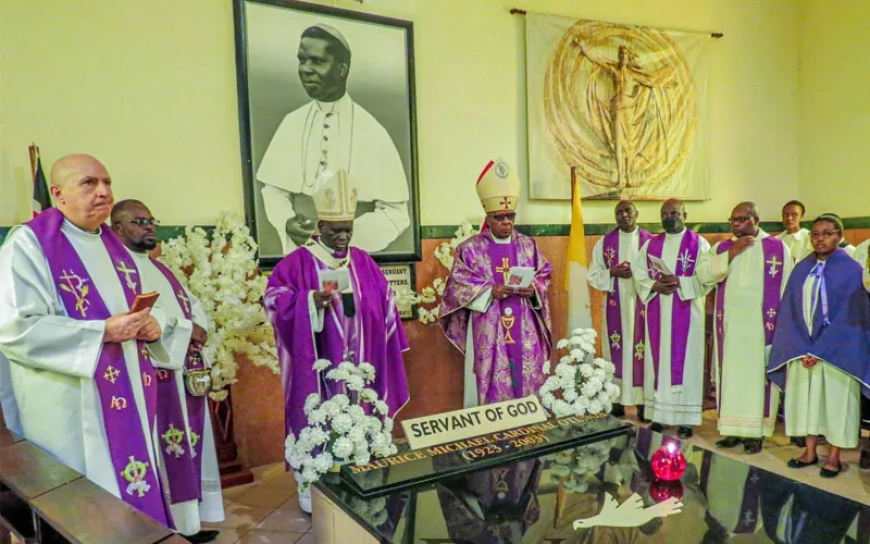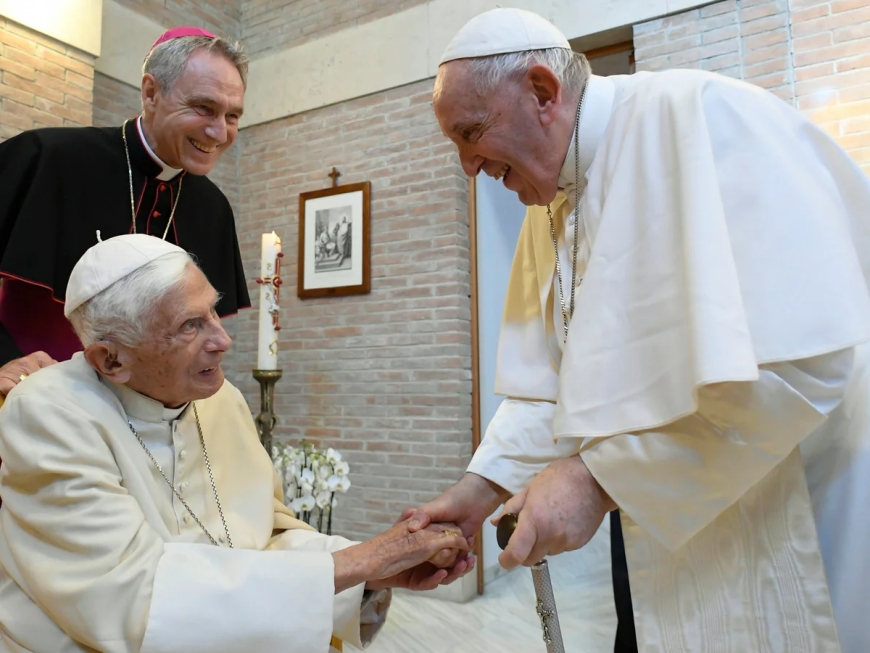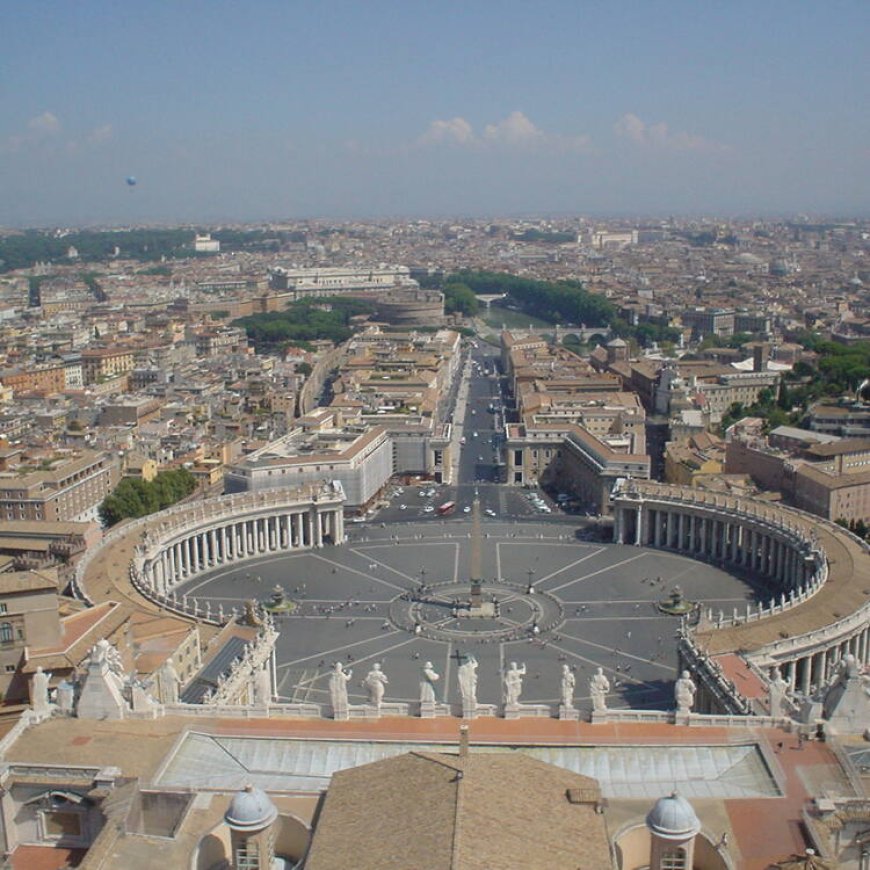No Phones, No Internet: How The Next Pope Is Elected
When the Pope dies or steps down, the Catholic Church gears up for one of its most mysterious and highly-ritualized events: the election of a new Pope.

As the Catholic church mourns the death of Pope Francis, attention now shifts to the Vatican as the process of selecting a new Pope begins.
When the Pope dies or steps down — like Pope Benedict XVI famously did in 2013 — the Catholic Church gears up for one of its most mysterious and highly-ritualized events: the election of a new Pope.

The late Pope Francis, right, shakes hands with the late Pope Emeritus Benedict XVI in the Vatican in August 2022. /THE GUARDIAN
This is not your average political vote. There is no campaigning, no televised debates, and certainly no Instagram ads. Instead, the process is steeped in centuries-old traditions, layers of secrecy, and intense spiritual symbolism.
So how exactly does it all go down? Let’s break it all the way down — from the moment the seat of St. Peter becomes vacant to the dramatic white smoke that signals the world: Habemus Papam — we have a Pope.
The Vacancy: “Sede Vacante”
The process starts when the Papacy is officially vacant — Latin term: sede vacante, which literally means “the seat being empty.” This happens either because the Pope has died or, in rarer cases, resigns.
If it is the former, tradition dictates that the Pope’s death is confirmed by the Camerlengo — essentially the Vatican’s top administrator during the transition — who verifies the death and takes charge of Church operations until a new Pope is elected.
Once the Papal office is vacant, the Camerlengo destroys the Pope’s Fisherman’s Ring — a symbolic gesture to show the end of his authority. The Vatican’s government is paused, and most top officials have lost their power during this interim phase. Only essential functions continue, and the focus shifts completely to organising the election.
Who Votes: The College of Cardinals
The job of electing a new Pope falls on a group called the College of Cardinals. These are the Church’s senior officials — most of whom are bishops — appointed by past Popes. But not all cardinals get to vote.
Only those under the age of 80 on the day the sede vacante begins are eligible. This rule limits the pool to around 120 electors (though that number can fluctuate slightly).
Most of these cardinals already hold major responsibilities across the globe. They are the Vatican’s inner circle: theologians, diplomats, administrators, and spiritual leaders with deep knowledge of the Church’s mission and current crises, and they’re the ones who, behind closed doors, decide who gets to wear the white robes next.
Conclave: Locked In, Phones Off
The actual voting happens in an event called a conclave — from the Latin cum clave, meaning “with a key.” It is a literal lockdown.
The cardinals are sequestered inside the Sistine Chapel, cut off from the outside world. No phones. No internet. No contact with anyone outside the voting body. The idea is to shield the electors from any kind of outside influence, media pressure, or political lobbying.
Before the conclave begins, the cardinals take an oath of secrecy. Violating it is considered a massive breach of Church law and can result in excommunication.
The Sistine Chapel itself is swept for electronic bugs, and even signal-jamming devices are used to prevent communication. It is not just old-school — it is secret-service level secure.
The Voting Process: Super Sacred and Ultra Secret
The election follows a strict and ancient protocol. The cardinals vote using handwritten ballots that they fold and place into a special urn. They vote up to four times a day — two rounds in the morning, two in the afternoon.
To win, a candidate must receive a two-thirds majority. That means if 120 cardinals are voting, the new Pope needs at least 80 votes. It is not about popularity — it is about consensus. The Church wants a leader who represents a strong and unified choice, not a split or controversial one.
After each round, the ballots are burned in a special stove inside the Sistine Chapel. If no Pope has been elected, a chemical is added to the smoke to make it black, signalling to the world that the voting continues. If a Pope has been elected, the smoke is white, and the bells of St. Peter’s Basilica begin to ring. That is when the world knows: a new era has begun.
Who Can Be Elected: Technically, Anyone. Realistically? A Cardinal.
Here’s the twist: technically, any baptised Catholic male can be elected Pope. In practice, though? It is always a cardinal. The last non-cardinal Pope was Urban VI — elected in 1378 — and the chances of that happening again are next to zero.
The cardinals usually elect one of their own — someone they know, respect, and trust. Often, he is already held major responsibilities in the Vatican or led a massive diocese somewhere in the world.
He may not even want the job (in fact, many don’t), but the election is considered the work of the Holy Spirit guiding the cardinals' collective discernment.
The Moment of Acceptance
Once a candidate secures the necessary votes, the Dean of the College of Cardinals — or the most senior among them — asks the chosen one the ultimate question: “Do you accept your canonical election as Supreme Pontiff?” If he accepts, he is immediately Pope.
Then comes another question: “By what name shall you be called?” The new Pope chooses a name, like Francis, Benedict, or John Paul, often inspired by past Popes or saints he admires. And just like that, a new chapter in Church history begins.
The Big Reveal: “Habemus Papam”
Soon after, the world sees the famous white smoke rising from the Sistine Chapel’s chimney.
Crowds gather in St. Peter’s Square. News agencies scramble. And then, the cardinal proto-deacon steps out onto the central balcony of St. Peter’s Basilica and announces in Latin: “Annuntio vobis gaudium magnum: Habemus Papam!” (Translation: “I announce to you with great joy: We have a Pope!”)

Aerial view of Vatican City. /UNESCO
The new Pope then steps out, often looking overwhelmed and humbled, to deliver his first blessing as the Bishop of Rome. The crowd goes wild. Cameras flash. The Church — and the world — begins to speculate what this new leader will stand for.
What Influences the Vote?
While the process is sacred, it is not free from politics. The cardinals bring their concerns and priorities into the Sistine Chapel.
Is the Church in need of a reformer? A strong administrator? A charismatic pastor? A global diplomat? Different factions exist — those who lean more traditional, others more progressive — and debates happen.
Recent Popes have each represented different directions: Pope John Paul II was a global figure and moral philosopher. Pope Benedict XVI was a conservative theologian. Pope Francis, the first Jesuit and the first Latin American Pope, prioritized the poor, the environment, and reforming the Vatican’s bureaucracy.
The next Pope could lean in any of these directions, depending on what the Church needs in that moment.






